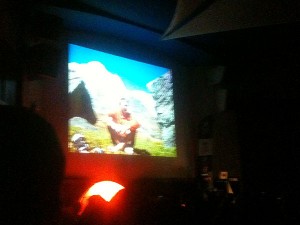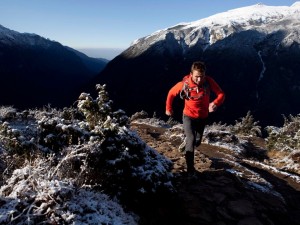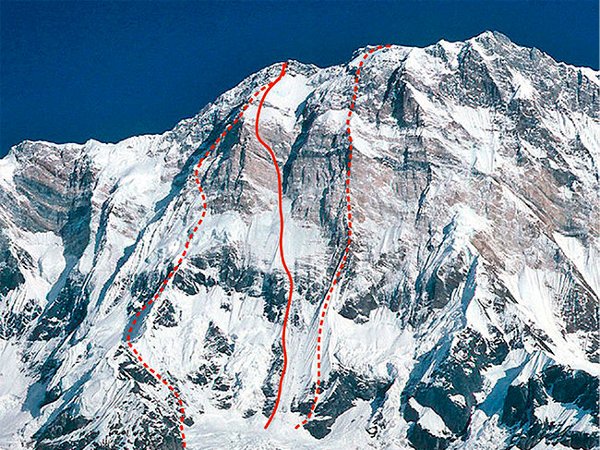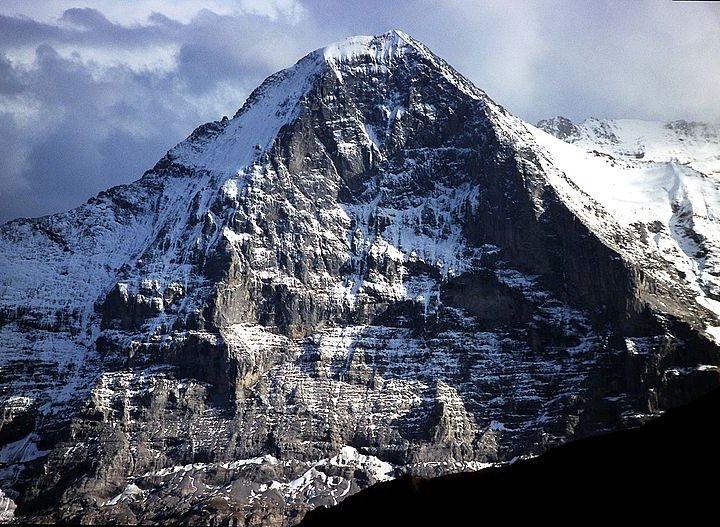A short while ago I attended a lecture by the Swiss climber Ueli Steck, known affectionately as the Swiss Machine, and later wrote about how ridiculous his mountaineering career has been. I used the word ridiculous in the nicest possible way, in the sense of being remarkable rather than absurd.

Last week I went to see him lecture again at the Royal Geographical Society in London. In 2013 he did something even more ridiculous which received widespread media publicity. I’m not talking about the punch up he got into with a team of Sherpas on Everest after his climbing partner Simone Moro called one of them a motherfucker in Nepali, but his ascent of the South Face of 8091m Annapurna in Nepal. He climbed the enormous 2500m wall of the world’s 10th highest mountain, which has only been climbed a handful of times, by a new route, solo, at night, in just 28 hours. It’s the sort of feat that could normally only be accomplished by a man in a cape wearing a pair of underpants outside his tights.
On this occasion he took us on a whistlestop tour of his nine expeditions to the 8000m peaks, which also began on the South Face of Annapurna in 2007. On that occasion his climb ended when he was hit by a rock and fell 200 feet, smashing his helmet and knocking himself unconscious. Undeterred, he returned there for another attempt the following year with his fellow Swiss Simon Anthamatten, but the expedition had more unhappy consequences. Ueli abandoned his attempt on the South Face due to the avalanche risk, but while at base camp he heard a trio of climbers, the Spaniard Iñaki Ochoa de Olza, Romanian Horia Colibasanu and the Russian Alexei Bolotov, were in trouble on the East Ridge. Bolotov was missing, and Ochoa and Colibasanu were holed up in a tent at 7400m with altitude sickness.
Ueli didn’t hesitate, and set off immediately in just a pair of ordinary walking boots (and the rest of his clothing, of course), but it was dark and before long he realised he would have to bivouac. He continued the following day past the three climbers’ Camp 2, where he bumped into Bolotov on his way down. The Russian was absolutely fine, and had summited the previous day. Ill-equipped for any more nights at extreme altitude, Ueli swapped his size 44 walking boots for Bolotov’s size 47 mountaineering boots and continued onwards. A little higher up he met Colibasanu struggling downwards. The Romanian was only capable of staggering a few yards at a time before collapsing in a heap, and looked to be in real trouble, but Ueli gave him a dexamethasone injection, and the drug worked its magic. Ueli continued upwards, and when he looked back Colibasanu was descending normally again. But when he reached Camp 4 at 7400m, Ueli realised Ochoa was in much more serious trouble inside the tent. He was barely moving and died soon afterwards. It was an uncomfortable experience for Ueli.

“During the night I realised I couldn’t sleep with a dead body next to me, so I dragged it outside and buried it in the snow,” said Ueli.
A jovial speaker who usually cracks jokes throughout his performance, Ueli had created a sombre mood around the hall, but he revived it by showing an EpicTV-style short video montage of himself performing various feats of extreme climbing set to loud heavy metal music. It was the live performance version of a commercial break, and he followed it up by telling us all about his training regime, which if anything seems to be just as extreme as his climbing.
“People think that Ueli Steck is a lucky guy who spends all his time in the mountains, but in fact I only spend about 20% of it in the mountains,” he said, “and I spend 80% of it in the gym.”
A typical day in the life of Ueli Steck involves weight training in the morning, and running or indoor climbing in the afternoon. He pointed out that by being fitter he makes his climbing much safer.
“If you are stronger then it means you can climb more quickly and stay out for longer. It increases the safety margin. I believe that is what happened to the Spanish and Romanian on Annapurna. They tried to keep up with the Russian, but Alexei Bolotov was one of the strongest climbers in the world.”
He continued his guide to the 8000ers by whizzing through his next two expeditions, to Gasherbrum II and Makalu in 2009. He dismissed the former, his first 8000m summit, in a couple of sentences and made it sound easy, but as someone who was climbing Gasherbrum II myself that year, I know otherwise. He was one of only two people to summit the mountain all season, and did it solo in decidedly marginal conditions when the rest of us were safely cowering in our tents at base camp. I myself spent 50 days at Gasherbrum base camp, and got no higher than Camp 2 on either Gasherbrum II or its big brother Gasherbrum I, so bad was the weather. According to Ueli, Makalu was not so straightforward. He climbed the standard route, made some mistakes and learned from the experience, but still he had climbed the world’s fifth highest mountain solo.

Next up were his three expeditions to Everest, or two of them anyway. In 2011 he attempted to climb it by the North Ridge, but turned around 100m short of the summit when he realised his feet were frozen.
“I didn’t want to lose any toes,” he said, “or that would be my rock climbing over. But it was strange. Oxygen can really help when it’s that cold, but I was climbing without oxygen, and there were all these people walking past me with oxygen thinking that’s Ueli Steck, the famous guy, and he’s turning around.” [A few chuckles from the audience.]
The following year, 2012, he reached the summit of Everest by the standard route on the Southeast Ridge. By climbing a few days earlier than most of the commercial groups, he found it relatively quiet with only about 20 other people on the South Col at the same time. While it was nothing spectacular by Ueli Steck standards, he clearly enjoyed the experience.
“It’s a beautiful mountain and it was a nice moment, but you know, at base camp on the south side it’s like Hollywood.” [Laughs from the audience.] “Everyone in mountaineering is there, there are always people you know, and the media is watching your every move. And you know, not everyone climbs Everest the same way. Some people climb with oxygen, some use fixed rope, and some people have Sherpas to carry their equipment for them. That’s fine – it’s up to you how you do it.”
It felt like Ueli was building up to talk about his expedition to Everest last year, when he was forced to leave the mountain early after becoming involved in a brawl with Sherpas who were fixing ropes for commercial teams. The incident produced a great deal of negative publicity. In the mainstream media it was presented as the culmination of a long running grievance of the Sherpas against their western employers, largely as a result of comments made by Ueli’s cameraman Jonathan Griffith. Meanwhile in the climbing community it became a feud between people in favour of commercial mountaineering and those against (a variation on the futile debate about climbing purity that is almost as old as mountaineering itself). I was expecting Ueli to talk a little about the incident during the lecture and present his side of the story, but he didn’t mention the 2013 expedition at all. While I was expecting him to, I’m actually glad that he didn’t. IMHO far too much has been written about something that is pretty meaningless. I still hold to the view I had at the time, that it was really no more than your average bar brawl, just in a slightly more exotic setting.

Instead Ueli concluded the lecture much more positively by describing his two great Himalayan solo speed climbs, on Shishapangma in 2011 and Annapurna in 2013. Although the climbs were completed solo, a comical element was provided by Ueli’s intended climbing partner for both ascents, the Canadian Don Bowie, who produced a lot of video footage documenting the climbs. How they ended up teaming up together Ueli didn’t tell us, but they couldn’t have been more different, and this meant they formed a great comedy double act that would have made Jack Lemmon and Walter Matthau proud. Square-jawed, forthright and serious, with a deep booming voice, Bowie oozed testosterone, while the more impish Ueli would to an outsider appear to be the less dominant member of the partnership. As we know, the opposite was the case. Ueli peppered his talk with footage of Bowie doing pieces to camera inside his tent.
“I’m feeling a little under the weather today,” he said in one of them at Shishapangma base camp. “But it looks good outside and Ueli said he thought the face looked solo-able. So I let him go on alone. I don’t want to stand in his way.”
He cut to long-range shots of a tiny black dot crawling up a giant snow-clad face. Ueli climbed the 2000m Southwest Face of Shishapangma in just 10½ hours.
“A little while later I see him running back down again and jumping over a bergschrund at the bottom,” we hear Don Bowie say.
There is even footage of this incident, and we see another black figure, rather like a James Bond assassin running across the rooftops, speeding down a distant slope, acrobatically leaping across a five metre drop over a crevasse and seamlessly continuing his run. We all roar with laughter. This is actual film of a real incident, not a 007 clip. And thanks to the wonders of modern communications, you can see virtually all the film he showed of Shishapangma on this single five minute YouTube clip.
Later on Don Bowie is doing another piece to camera inside his tent high up on Annapurna. This time he looks exhausted and is pausing for a breath at the end of every sentence, rather like he’s dying for a crap, though it’s possible he’s suffering from some mild form of altitude sickness after trying to keep up with his hyperactive climbing partner. Outside the tent Ueli is prancing around like a leprechaun, clearly full of energy. When the pair left on their summit attempt last year, Bowie turned back very early on, leaving Ueli to go on alone once again.
A wise move. “I didn’t feel comfortable up there,” Bowie says to camera with the huge South Face behind him. “Ueli is a way better climber than me. The conditions were good for him, but I decided to turn around. When I looked up there later in the day, he had already reached the place we were intending to camp and had gone on.”

The camera zooms in beyond Bowie’s shoulder, and again we can see a tiny figure crawling up the face. Ueli shows some more footage of Don Bowie inside his tent talking to camera. This time he is with Swiss photographer Dan Patitucci.
“If the weather is good tonight I think Ueli will climb through the night,” says Patitucci.
“No way. It’s way too dangerous to climb the face in the dark,” Bowie replies. “He’ll hole up for the night and continue at first light.”
They were probably both right. The South Face of Annapurna is way too dangerous to climb at night, but as Dan Patitucci correctly surmised, that’s not going to stop Ueli Steck.
Ueli described how the weather seemed to be perfect, so just before dusk he decided to remove a glove, reach for his camera and take a photograph of the route above him so that he could continue in the dark and refer to it if he became lost (what a great idea!). At that moment he was hit by a spindrift avalanche. He was standing on a 60° snow slope, so he instinctively reached for his axes to anchor himself into the surface, dropping both the camera and his glove in the process. He sheltered in a crevasse for a couple of hours, where he left much of his equipment to make a rapid push for the summit carrying very little. The conditions were perfect, and he was able to climb on snow and ice pretty much all the way up.
“When the slope was easier I turned off my headlamp to save battery,” he said. “I didn’t know whether I could reach the summit, but everything was going well so I just kept going. Then I reached the ridge and kept going up. I reached a place and switched on my headlamp and I realised there was no place higher. I was on the summit, but I couldn’t take a picture because I didn’t have my camera, so I came down again straight away.”
And once again you can relive some of the magic of the climb here.
Ueli admitted that his climb had been extremely risky. When he left on his summit assault he had just one small rope, one litre of water, a single glove and a very light jacket. The margin for error was zero. A misplaced foot would likely have sent him to his death, and he couldn’t stop for a single moment or he would become too cold. If the weather deteriorated he would have to keep going. Had it been any other climber in the world then the lack of a summit photo would likely have led to controversy, with people eager to challenge his claim to have reached the summit. But there has been no such controversy, and no one is in any doubt that Ueli did indeed accomplish this remarkable ascent.
I have called this post Ueli Steck’s guide to the 8000m peaks, but I wouldn’t recommend any of this yourself, whoever you are.
We finished with a question and answer session, and although the hall was full there was no shortage of people brave enough to put their hands up. The questions were of variable quality, as you might expect, with plenty of vague questions about motivational techniques, but some good direct questions as well. Someone asked what it was like to climb with the legendary Swiss climber Erhard Loretan, and Ueli described how Loretan’s 43 hour ascent of the North Face of Everest in 1986 had been ahead of its time and an inspiration for his own speed ascents. Somebody else asked about Ueli’s approach to risk management, but I missed the answer because I temporarily dropped into a coma as soon as I heard the words risk management. My friend Dan was offering me increasingly large sums of money to put my hand up and ask what the Nepali is for motherfucker, but it didn’t seem the right moment. One quite facile question produced an entertaining response.

“What’s your favourite mountain?” somebody asked.
“My favourite mountain? There’s no favourite mountain. Every mountain is different, but I suppose from where I live at Interlaken in Switzerland the Eiger is only half an hour by train, so I suppose it would have to be the North Face of the Eiger.”
Everybody laughed.
“Will you be doing any more speed ascents of the Matterhorn and the Eiger?”
Ueli appeared to be lost for words before supplying an emphatic single syllable response. “No.” There was a pause, and we thought that was all he was going to say, so we all started laughing again, but there was more.
“You can’t keep taking the risk and climbing it faster and faster. A few years after I climbed the Eiger in 2 hours 47 minutes Dani Arnold did it in 2 hours 28, so he was nearly twenty minutes faster than me. As soon as he did it the media were asking me if I was going to go back and beat it. But I said no way. There isn’t going to be a competition to beat it again and again.”
The final question was about Ueli’s superstar image in the media. “You seem a humble guy,” said the questioner. “How do you feel about people looking up to you as a superstar?”
“You know, I’m not so comfortable with it. In the media I know they call me the Swiss Machine. But I am not a machine. I’m just a normal guy.”
Yeah right, Ueli.







I attended this lecture as well, and was absolutely transfixed. Ueli Steck is incredible and so very humble and modest about his incredible achievements, whilst also being very aware of and acknowledging the risks he took. I felt honoured to hear him talk – seems like an over-dramatic word to use given I just bought a ticket and showed up at a lecture theatre. Although was very aware of how much the Everest incident wasn’t mentioned and wondered if anyone would ask a question about it.
Glad you liked the lecture, Jo. It helps when you have so many great achievements to talk about, but he is also a good speaker, and you are right that he comes across as quite humble. There are not many like him, so I don’t think honoured is too strong a word.
I really enjoy your posts about lectures, and Ueli has been my favorite mountaineering for a while now. I am amazed at his accomplishments, of course, but also at how nice he seems – he comes across as humble, as you said, but also fun and I worry that if I meet him some day I will be screaming like a teenage fan girl.
I can’t wait to see what he will do next!
Heehee, I think Ueli’s next project is to find a way of escaping from screaming teenage fans. Let’s see how quick he really is!
Thanks Mark. I always enjoy reading your lines. Like Reinhold Messner said ones “Well…It’s Ueli Steck, what can I say”
José
Thanks, glad you like the post. Ha, well Messner can talk. 😉
As one who is not able to attend these wonderful lectures given by amazing guys I really appreciate your postings. He sounds to be a wonderful guy and it’s interesting to hear folk say how humble he is as that doesn’t always come across. On the other hand I always read media postings with caution as we all know they always exaggerate in order to sell the papers. Thanks then for posting a first hand experience and common sense view. Cheers Kate
Thanks, Kate. Glad you like the posts about mountaineering lectures. Sorry they’re not as good as the real thing. Maybe Ueli will come to Yorkshire one day!